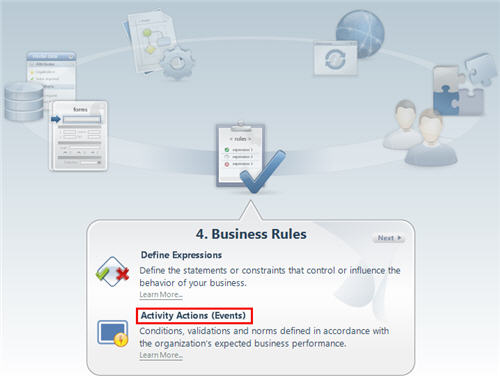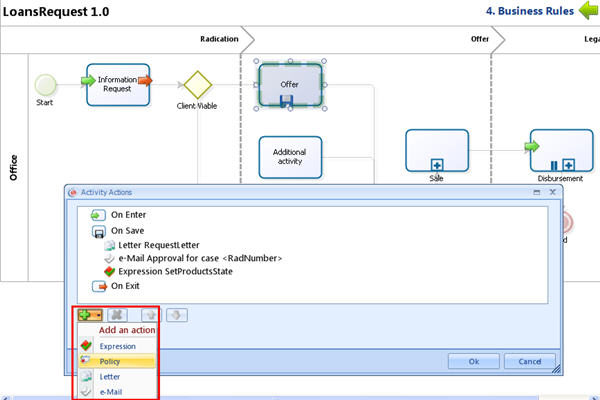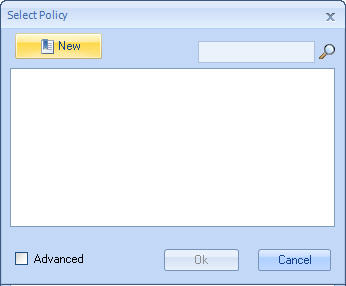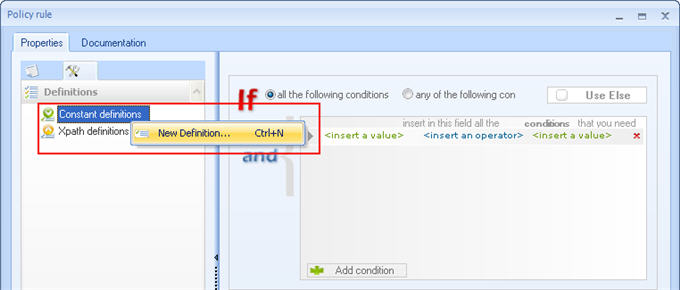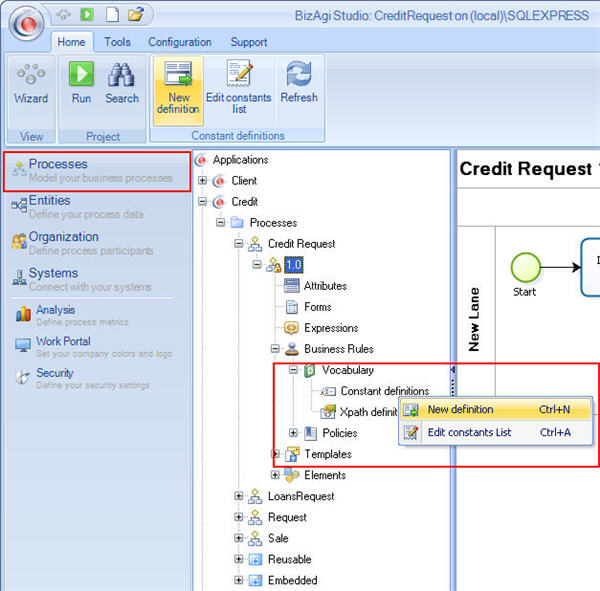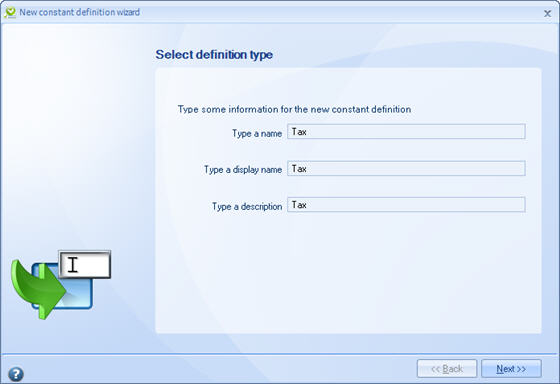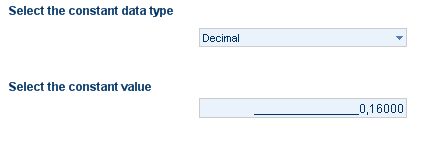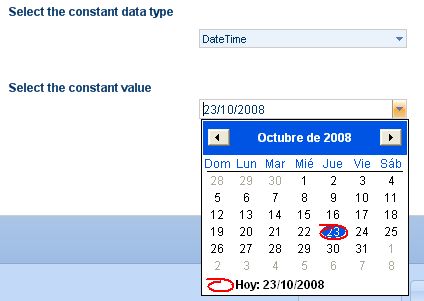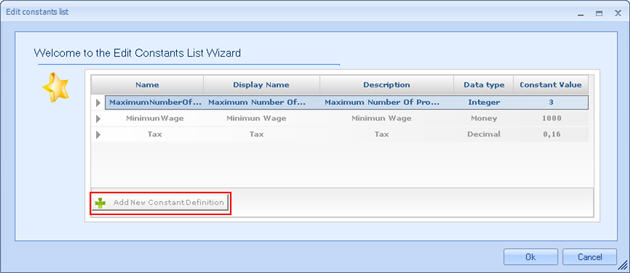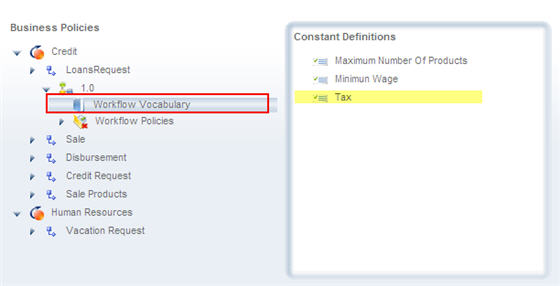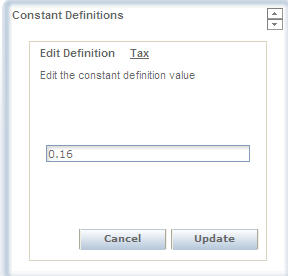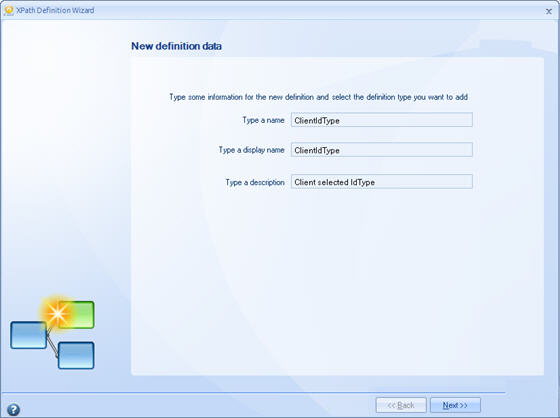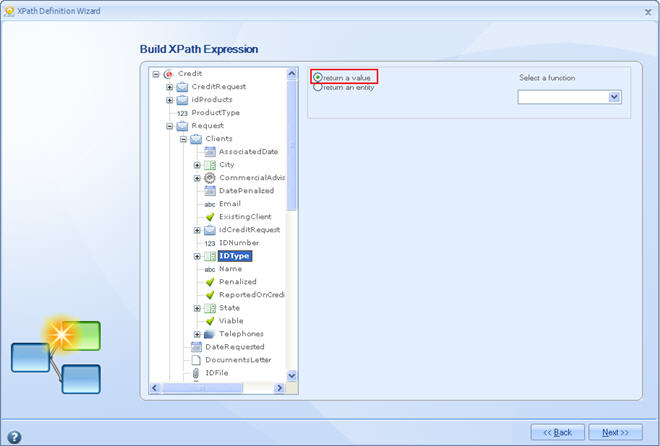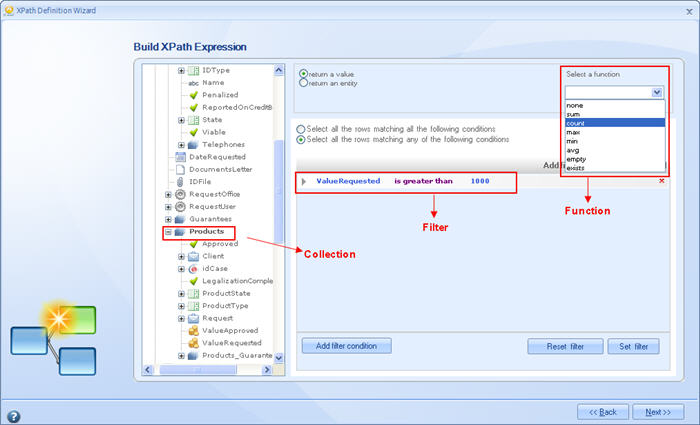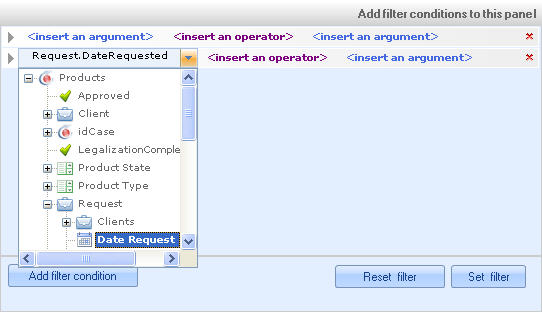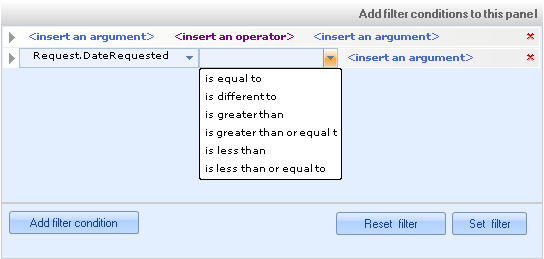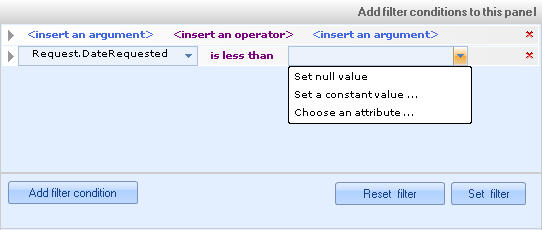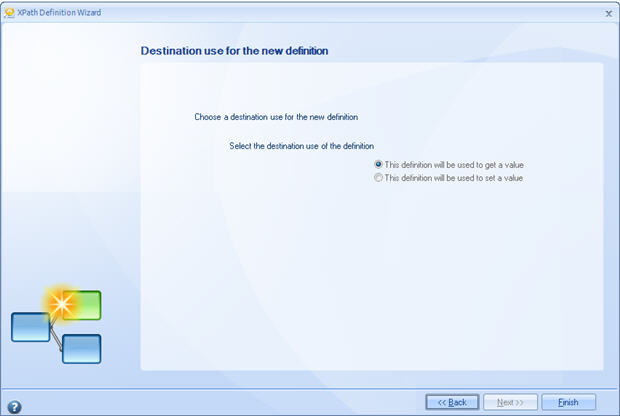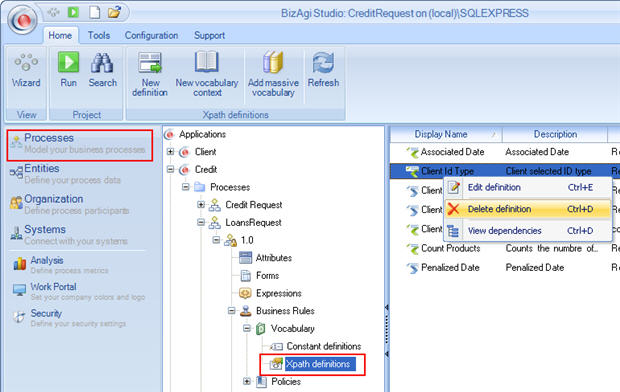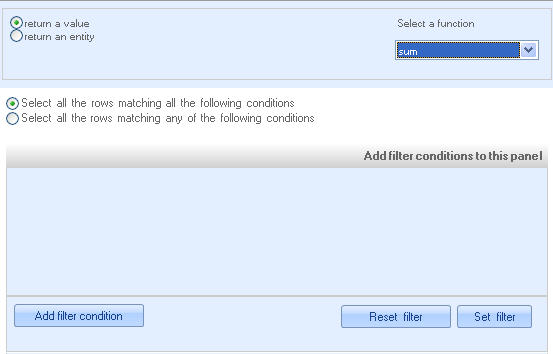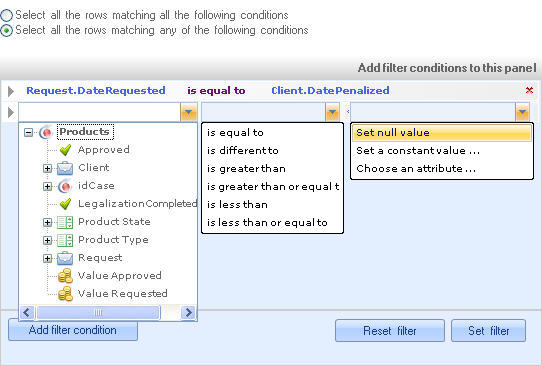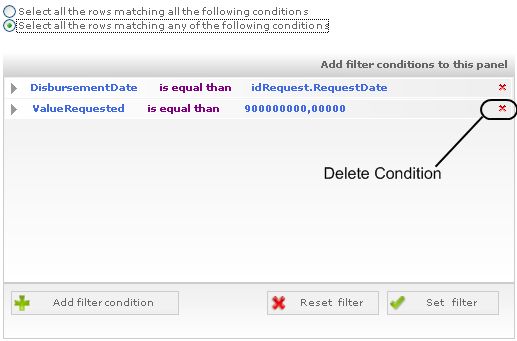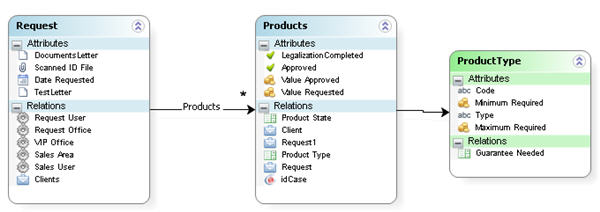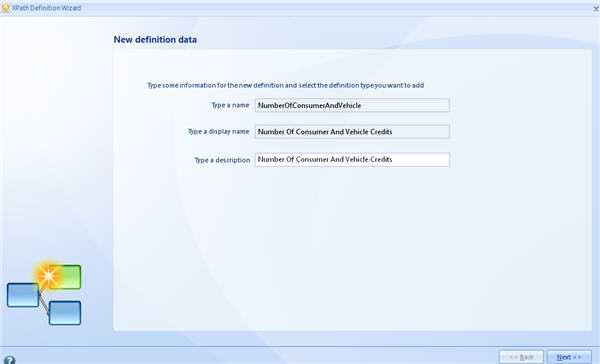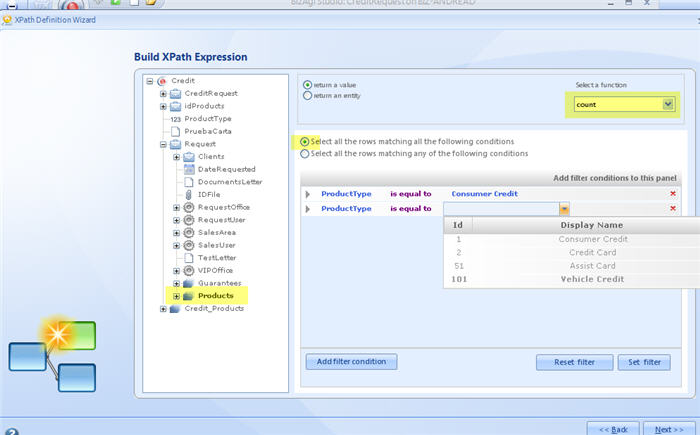Vocabulary
From Business Process Management, BPM and Workflow Automation Wiki | BizAgi BPMS
<keywords content="keywords">
vocabulary, definition, definitions, create, edit, xpath
</keywords>
Contents |
Vocabulary
Vocabulary are definitions that obtain or set all the information used in the Policies; they can be Constant definitions or XPath definitions (values from the data model).
The operation of the Policies is based on the definitions of the vocabulary.
There are three ways to create vocabulary:
From the Process wizard, from the Processes Menu, when creating a Policy.
How to Create Vocabulary from the Process Wizard
1. Go to the Business Rules Step (step 4) and select Activity Actions
2. Click on the shape where the policy will be created and select On Enter, On Save or On Exit to create the policy
3. Create a new policy
4. When the new policy is opened, right click on Constant or XPath definition and select New Definition
How to Create Vocabulary from the Processes Menu
1. Go to the Processes Menu.
Select the process where the vocabulary will be created. Then, select: Business Rules and then Vocabulary.
Right click on Vocabulary and select New Definition
How to Create Vocabulary when creating a Policy
When a policy is being created or edited, the user can add vocabulary.
To create a vocabulary when creating a policy please click HERE
Constant Definitions
The Constant Definitions acquire values that do not depend on the data model. These values can be modified through the Web application.
Example:
|
Definition |
Expression |
|
Tax |
0,16 |
|
Minimum wage |
200USD |
|
Maximum products allowed |
3 |
How to create Constants Definition
1. When the New Definition is selected (see the previous section) a new window is displayed, to name the Constant. The expressions must be self-explanatory because these expressions or definitions will be used when the policies rules are configured.
2. Click on the Next button to select the constant data type for the new definition:
The corresponding editor will be displayed for each data type.
For a calendar, select the day for the constant value from the displayed scheduler:
4. Click in the button Finish after the data type has been selected.
How to edit Constant Definitions
It is possible to change all the Constant definitions together for each process.
1. To do so, right click on Constant Definitions and select Edit constants List.
2. A list of the defined constants is displayed in the window Edit Constant List; the constants displayed can be edited or created after selecting the button Add Constant Definition, which inserts a new row in the table.
3. Click on OK to save the changes.
How to Edit Constants Definitions in the Web Application
The definitions of constants, acquire values that do not depend on data model: attributes of the application; therefore, the values of these data can be modified in the execution environment through the Web application.
1. Go to the Admin Menu, and select the Business Policies option.
2. Select the Process where the vocabulary is created and click on the vocabulary to change it.
The edition window will be displayed depending on the selected data type after clicking on the name. Click on the Update button once finalized the data edition
When a project is taken to production, all the Policy definitions will be taken to the Production environment in the first Deployment. Henceforth, the environments will be handeled individually. If you want your definitions to be synchronized, we recommend to perform changes in the Development environment as well.
XPath definitions
These definitions represent expressions, that obtain values from within the business data model. In contrast to the constants definitions the Xpath must be associated to the process.
XPath definitions can take information from one to many relationships (records count, averages, sums, minimum and maximum).
This definitions are meant to be used and changed in the web application; when they are created its name should be as clear as possible, so they can be understood by the final users.
For example:
|
Definition |
Expression |
|
Client ID type |
<Request.Client.IDType> |
|
Number of Credits Requested |
<count(Request.Request_Products)> |
|
Total Amount Requested |
<sum(Request.Request_Products.RequestedAmount)> |
How to create XPath Definitions
1. When the New Definition is selected (see the first section) a new window is displayed, to name the XPath.
The name must be self-explanatory because these definitions will be used in the web application when the policies rules are configured.
2. The window to select the Xpath from the data model is displayed; Click on the next button when the attribute has been selected.
3. The definition can take information from a one-to-many relationship (Collection). Here an attribute can be selected. This will return a collection that contain that selected attribute.
There are also functions available.
- Sum: returns the sum of numbers or currency
- Count: returns the number of records found in the selected collection
- Minimum value: returns the smallest number of the collection
- Maximum value: returns the largest number of the collection
- Average: returns the average of numbers or currency
- Empty: returns true if the collection is empty, or false if it is not.
- Exists: returns true if an attribute with a condition is found in the collection.
The operations can be performed on all the records related to the relationship or the records can be filtered.
4. The use of the new definition is selected in the following window. If the XPath definition will be used to assign values on the associated attribute, or the Xpath definition will be used to get the attribute’s current value:
5. Click on the Finish button after selecting the use that will have the definition.
Advanced Properties of XPath Definitions
- Massive Vocabulary: Create many definitions with just one click
- Contexts in Vocabulary: Create a definition to evaluate attributes within a collection
- How filter the records of a Collection
1.Identify the XPath Definition and right click on it; select the option Edit Definition.
2.The definition editor will be opened. Follow the same steps explained in Creating the vocabulary.
1.Identify the Vocabulary within the selected process. Right click on the definition; select the option Delete Definition.
2.A confirmation screen will be displayed when selecting this option; click on the Yes button to delete the definition. Definitions currently in use by a policy cannot be deleted.
The records of the relation can be filtered with different conditions after the respective selection of the relation. In the work area the user must specify whether all the conditions or just one condition must be fulfilled.
![]() AND: All the following conditions.
AND: All the following conditions.
![]() OR: Some of the following conditions.
OR: Some of the following conditions.
The option where all the conditions must be fulfilled is marked by default.
All the records of the relation are retrieved when a filter is not created.
1.Click on the button filter to add a condition. A record is inserted in the table when selecting this option; the following information must be entered in the table:
Left Operator: Where the attribute to be evaluated in the condition must be selected. A window containing the data model tree will be displayed to ease the selection.
Operator: Select the operator desired for the condition.
|
Attributes |
Operators |
|
Numerical attributes |
Equal, Different, Less Than, Less Than or Equal, Greater Than, Greater Than or Equal |
|
Text attributes |
Equal, Different |
Right operator: in this field a constant value or an attribute value can be selected to complete the condition. A window containing the possible selections.
Click on the left side of the condition to delete if necessary; press the delete key. A window to confirm the deletion will be displayed.
Create a vocabulary that gets the number of Consumer credits and Vehicle Credits in the Request.
In this example we assume there is a one-to-many relationship (collection) between the request and the products requested. That is, in every request there are several requested products.
A XPath definition must be created to store the number of credits that fulfills the condition.
1. Create the Xpath Vocabulary
2. Select form the data model the Products Entity and create the two filters.
Remember to select all the rows matching the conditions, and finally to select to count the records that fulfill the conditions.
3. Click on next button; select the option “This definition will be used to obtain a value”. Click Finish to save changes.
Related Articles
- Policies
- Massive Vocabulary: Create many definitions with just one click
- Contexts in Vocabulary: Create a definition to evaluate attributes within a collection
- How filter the records of a Collection
<comments />
